Scorecards deliver an overview of performance in a single location. Focusing on the objectives of the organisation, scorecards bring together data that may originate in multiple disparate sources allowing you to move from the high level indication of performance to investigate and drill into individual issues within the constituent elements that drive that performance.
SAP Strategy Management’s scorecard contains multiple modules, including objective and KPI-based views, that provide a centralised and personalised view of progress toward desired outcomes. For whatever purpose at hand — whether using an objective scorecard to monitor performance toward goals; or a KPI scorecard to consolidate key financial and operational metrics — SAP Strategy Management’s flexible and multi-purpose scorecard acts as a beacon to provide a rounded view of performance.
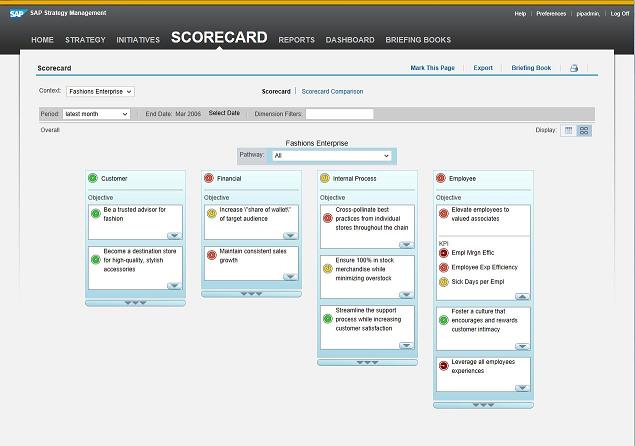

- KPI scorecard provides a summary view of multiple key performance indicators
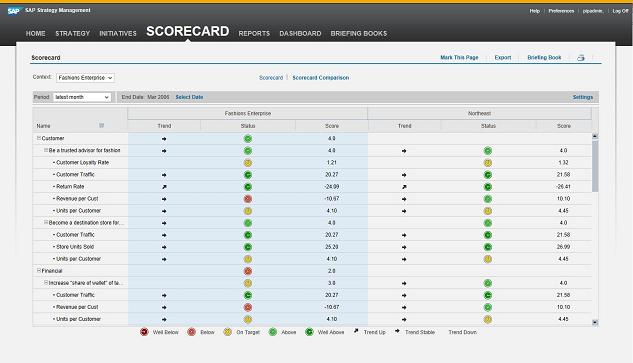
Compare Business Unit performance side-by-side to identify outliers 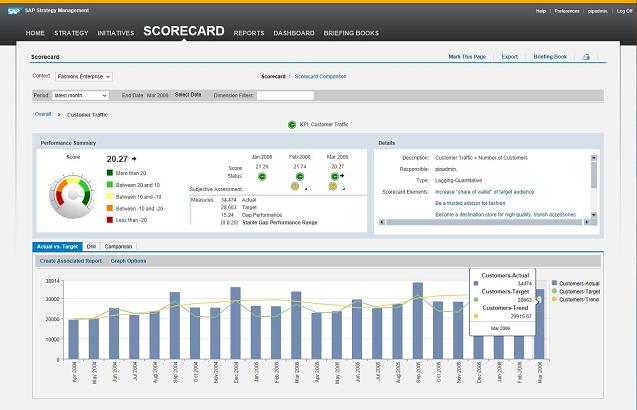
KPI detail provides underlying details about a KPI’s performance measures 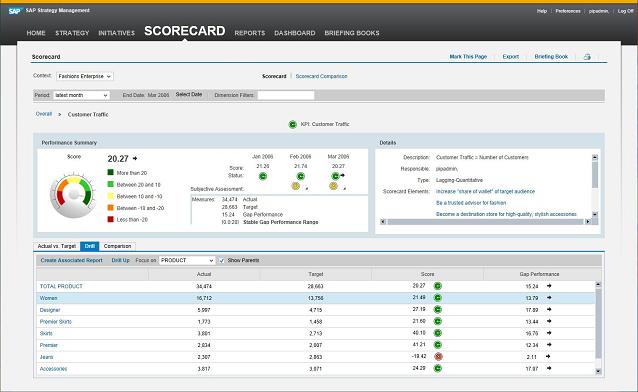
Drill into KPIs to identify underperforming regions or market sectors 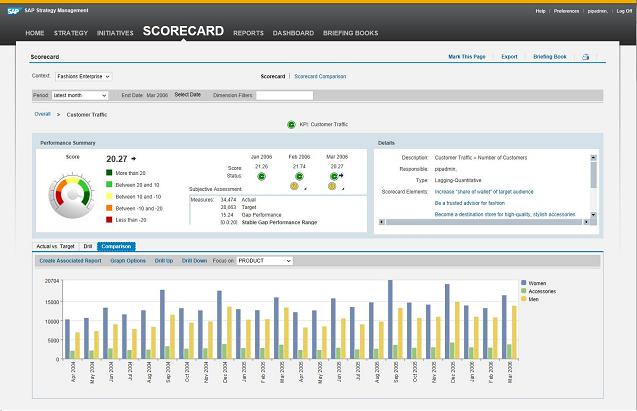
Compare performance against internal or external benchmarks
Key features and benefits
- Objective scorecards: Unlike traditional metrics-based dashboards, objective scorecards provide an at-a-glance summary of progress towards goals which may be based on multiple indicators of performance. Includes a comparison of actual vs. target, notification of underlying KPIs in trouble, and the ability to filter on Themes or Pathways.
- Perspective and Objective detail: Provides complete details for a specific objective, including associated KPIs, their status and trend, description, owner, comments, associated initiatives, and links to related external information.
- KPI scorecards: Provides summary views across all KPIs, with at-a-glance comparisons of current actuals vs. historical performance, along with the ability to filter KPIs by time, owner, status, trend, and type of indicator or objective (e.g., leading/lagging, etc.). Choose additional elements from the range available to personalise your scorecard without the need for IT involvement.
- KPI detail: Provides complete details for a specific KPI, including its description, owner, score, trend, external and internal benchmarks, comments, and links to related external information.
- Filter objectives and KPIs by specific characteristics: Focuses displays of objectives and KPIs by specific properties such as owner or status, focusing attention on items that demand immediate attention. Alternatively filter the scorecard by a particular segment or switch from one periodicity to another in seconds without the need to re-run queries.
- Compare KPIs against external and internal benchmarks: Links internal and external metrics, such as those provided by third-party benchmarking companies, to create a truly comprehensive 360° picture of operational performance. Provides additional context for KPIs and how they measure up to other internal benchmarks. For example, compare one region or time period against another.
- User-definable performance thresholds: Define either 3 or 5 threshold ranges for the difference between actual and target performance for both Perspectives, Objectives and KPIs to provide an immediate gauge of status. Each individual Perspective, Objective or KPI can be defined differently to reflect its particular needs.
- Cascading and comparison scorecards: Provides a unified view of key performance drivers across functional and divisional units; integrate financial and operational measures to provide a holistic view of the state of the organisation. View performance of the different business units side-by-side to highlight discrpancies in performance.
- Track any type of KPI: Define any type of KPI — leading/lagging, qualitative/quantitative, subjective/objective, financial/operational, etc. to enable a truer gauge of performance status. SAP Strategy Management’s sophisticated analytical engine enables organisations to define simple qualitative KPIs or multidimensional quantitative KPIs.
- Monitor “soft” objectives: Monitoring intangible or subjective objectives, such as using qualitative or operational KPIs, enables the association of meaningful key performance indicators for all objectives, regardless of whether they are financial, subjective, or operational.
Subjective assessments: Allows KPI owners to flag up incidences where, for whatever reason, the score as calculated based on data available hides a different reality, giving the person responsible the option to indicate their view of what current status is and their reasoning for this. - Combine multiple KPIs into one score: Combining KPI scores, even those of financial KPIs with operational ones, delivers a more meaningful view of performance status. Weighting is available so each KPI reflects their relative importance in meeting that objective.
- “Placeholder” KPIs: Creating KPIs before associated data is populated in the system facilitates collaboration on KPI definition without affecting higher level analyses until consensus has been reached.
- Defining KPIs: SAP Strategy Management provides more options and flexibility in KPI definition, which in turn delivers more accurate and meaningful performance information.
Tel: +44 (0)870 166 2435, Fax: +44 (0)870 054 8795, Email: info@issel.co.uk
© 1996-2017 ISSEL Intranet Software Solutions (Europe) Ltd. All rights reserved
